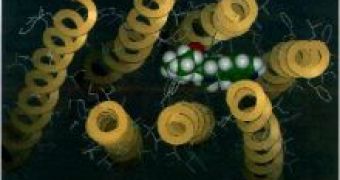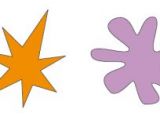Synaesthesia, the blending of the senses, once thought to be a mere curiosity, provides important clues to understanding the organization and functions of the brain. Why do some people have a certain sensation of color when they hear or see the shape of a number or letter? Or why do some people experience tastes when touching things? And is the normal ability for creating and understanding metaphors an abstract form of synaesthesia?
For some time, the phenomenon of synaesthesia was not taken seriously. One explanation was that people having synaesthesia were actually experiencing, in an unusually vivid manner, memories. For example if one would experience the color red when looking at a black letter A, it might be just because when he was a child he had learned the letters with some game that had colored letters, and letter A was red. This seemed to be supported by the fact that synaesthetes actually realize that the letter A is not really red, they do see it's black, but on top of that they have the associated experience of color red. Sometimes the synaesthetes themselves believed that maybe their vivid experience was only a memory.
Another explanation was that synesthetes were merely being metaphorical when they described the note C as "blue" - just as we might speak of a "hot" shirt or "sharp" cheddar cheese. Our ordinary language is replete with such sense-related metaphors, and perhaps synesthetes are just especially gifted in this regard.
Scientists have began to take synaestesia seriously since the late 1990s when several simple tests were conducted showing that synaestesia involves a genuine perception phenomenon. One such simple test is shown in this picture. When the left image is presented to normal people, they find it difficult to distinguish the 2s from the 5s. However, synesthetes who get a sensation of e.g. green when they see a 5 and a sensation of red when they see a 2 immediately identify the 2s among the 5s. Moreover, they are doing it with the same speed as one normal individual is doing it when he is presented the right picture (where the numbers are actually colored). This shows that the synesthetes are not faking it; they do have a genuine sensation of color. Scientists then started to wonder what the neurological cause of this phenomenon is. When they have looked at the available synesthesic phenomena (such as sound-color, shape-color, shape-taste etc.) they have found that the areas in the brain specialized in one aspect, e.g. interpreting shapes, is close to the area specialized in another aspect, e.g. interpretating color. Furthermore, they have found that all the brain areas specialized in interpreting something (color, shapes etc.) send their signals to other areas of the brain, conducting higher forms of interpretation, that are also situated near each other (somewhere near the TPO, for temporal, parietal, occipital lobes, junction). They have also found, by documenting numerous cases of synaesthesia, that it is a genetically transmitted condition.
So the questions were: How exactly do some areas of the brain influence a nearby area, via neural cross wiring or via chemical cross activation? And where exactly does the cross influencing happen, between the higher interpretative areas or between the lower ones?
Initially, scientists leaned towards the idea of neural cross wiring between the lower interpretative areas. In the end, they have reached the conclusion that what happens is a chemical cross activation between the higher interpretative areas. There are many evidences, but I will mention only two of them.
First of all, the idea that the synaesthesia isn't caused by neural cross wiring, but by a certain chemical imbalance is supported by the fact that certain drugs, such as LSD and mescaline, also produce synaesthesia. These drugs have a chemical structure that mimics the chemical structure of neurotransmitters (the substances that connect one neuron with the other). Thus, when such a drug enters the brain, the neurons are caused to send signals without the existence of real external stimuli (this is why they produce all sorts of hallucinations). Some mental illnesses such as paranoid schizophrenia are also caused by a similar cause: the overabundance of naturally produced neurotransmitters. Thus, synaesthesia has a chemical cause: it is produced either by the leaking of natural neurotransmitters from one area of the brain into a nearby area, or by the absence of some inhibitors (the brain manages contradictions with the help of chemical inhibitors: when a certain process occurs some other process is being inhibited). Apparently, synaesthesia is caused by the latter: the absence of inhibitors. That's why one can get the sensation of red even if in the same time one gets, from perception, the sensation of blue (if one looks at a blue number) - the actual color of the number causes one sensation of color, while the number itself causes another sensation of color, and the synesthete has no problem managing this apparently contradictory situation.
Secondly it is found that synesthetes having one form of synaesthesia are more likely to experience some yet another form of synaesthesia. Moreover, according to one study, synaesthesia is seven times as common in artists and creative people as in the general population. One important ingredient of creativity is the ability to make metaphors and analogies between apparently remote domains. Thus, this seems to suggest that synesthesia occurs in the higher interpretative areas of the brain. "In addition to clarifying why artists might be prone to experiencing synesthesia, our research suggests that we all have some capacity for it and that this trait may have set the stage for the evolution of abstraction-an ability at which humans excel. The TPO (and the angular gyrus within it), which plays a part in the condition, is normally involved in crossmodal synthesis. It is the brain region where information from touch, hearing and vision is thought to flow together to enable the construction of high-level perceptions," Vilayanur S. Ramachandran and Edward M. Hubbard, the authors of one detailed study write.
Do we all have some synaesthetic abilities? Look at this test designed by Wolfgang K?hler. Which one of these figures bears the name 'booba' and which one is called 'kiki'? According to Kohler's study, 95% to 98% of people choose Kiki for the orange angular shape and Booba for the rounded shape. "Perhaps that is because the gentle curves of the amoeba like figure metaphorically mimic the gentle undulations of the sound 'bouba' as represented in the hearing centers in the brain as well as the gradual inflection of the lips as they produce the curved 'booba' sound. In contrast, the waveform of the sound 'kiki' and the sharp inflection of the tongue on the palate mimic the sudden changes in the jagged visual shape. The only thing these two kiki features have in common is the abstract property of jaggedness that is extracted somewhere in the vicinity of the TPO, probably in the angular gyrus. (We recently found that people with damage to the angular gyrus lose the bouba-kiki effect- they cannot match the shape with the correct sound.) In a sense, perhaps we are all closet synesthetes. So the angular gyrus performs a very elementary type of abstraction-extracting the common denominator from a set of strikingly dissimilar entities. We do not know how exactly it does this job. But once the ability to engage in crossmodal abstraction emerged, it might have paved the way for the more complex types of abstraction", wrote the authors of the study.

 14 DAY TRIAL //
14 DAY TRIAL // 


